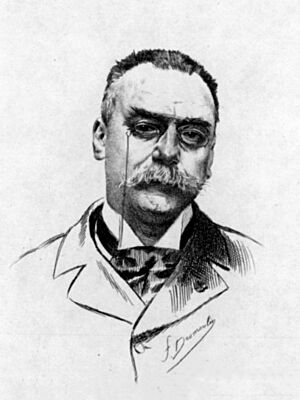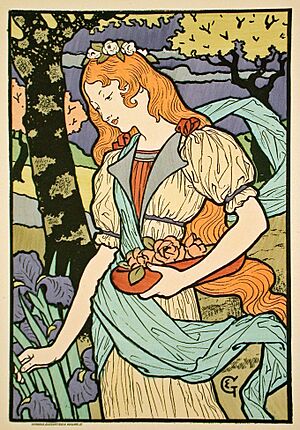Eugène Grasset facts for kids
Quick facts for kids
Eugène Grasset
|
|
|---|---|

Eugène Grasset, from Joseph Uzanne, Album Mariani, vol III; Paris: Floury, 1897
|
|
| Born | 25 May 1845 Lausanne, Switzerland
|
| Died | 23 October 1917 (aged 72) Sceaux, Hauts-de-Seine, France
|
| Style | Art nouveau |
Eugène Samuel Grasset (born May 25, 1845 – died October 23, 1917) was a talented artist from Switzerland. He worked in Paris, France, during a time called the Belle Époque, which means "Beautiful Era." Grasset was a leader in a new art style known as Art Nouveau. He created many different types of designs, from furniture to posters.
Contents
Who Was Eugène Grasset?
Eugène Grasset was born in Lausanne, Switzerland, on May 25, 1845. His father was a cabinetmaker and sculptor, so Grasset grew up surrounded by art. He learned how to use tools like chisels from a young age.
Early Life and Studies
Grasset studied drawing with Francois-Louis David Bocion. In 1861, he went to Zürich to study architecture. After his studies, he visited Egypt. This trip later inspired many of his poster designs. He also loved Japanese art, which influenced his work.
Moving to Paris and New Designs
From 1869 to 1870, Grasset worked as a theater painter and sculptor in Lausanne. There, he met Eugène Viollet-le-Duc, an architect who believed that art should connect form, function, and materials. This idea greatly influenced Grasset's future work.
In 1871, Grasset moved to Paris. He began designing many different things:
- Furniture
- Wallpapers
- Fabrics and tapestries
- Ceramics and jewelry
He also created special wooden parts for buildings. His beautiful art pieces often used materials like ivory, gold, and other precious items. His designs became a key part of the Art Nouveau style.
Grasset's Famous Graphic Art
In 1877, Eugène Grasset started working in graphic design. He made things like postcards and even postage stamps for France and Switzerland. But his best work was in poster art. He used the ideas of Viollet-le-Duc in his posters.
Posters and Logos
Some of Grasset's posters were so famous they became part of the Maîtres de l'Affiche (Masters of the Poster) collection. One well-known poster was "Jeanne d'Arc Sarah Bernhardt." In 1890, he designed the "Semeuse" logo for the dictionary publishers, Éditions Larousse. This logo shows a woman spreading dandelion seeds.

Working with American Companies
French posters became very popular in the United States. Soon, American companies asked Grasset to design for them. In the 1880s, he got his first American job. He designed the cover for the 1892 Christmas issue of Harper's Magazine.
In 1894, he created "The Wooly Horse" and "The Sun of Austerlitz" for The Century Magazine. These images helped advertise a story about Napoleon Bonaparte. "The Wooly Horse" was so popular that artist Louis Comfort Tiffany even made it into a stained glass artwork. Grasset's work in the U.S. helped the Art Nouveau style become popular there.
Teaching and Typeface Design
Grasset also taught design at several schools in Paris:
- École Guérin (1890-1903)
- École d’Art graphique (1903-1904)
- Académie de la Grande Chaumière (1904-1913)
- École Estienne
He wanted to create his own alphabet for a book about his design methods. This alphabet was based on the work of Nicolas Jenson from 1471.
The Grasset Typeface
A company called Georges Peignot bought Grasset's alphabet design. On October 7, 1897, they officially patented the design as the "Grasset" typeface (a set of letters and numbers for printing). Henri Parmentier then carved the letters for printing.
In 1896, Grasset published a book about using plants in designs. This book included drawings made by his students. Some of his famous students included Paul Berthon, Augusto Giacometti, Mathurin Méheut, and Eliseu Visconti.
At the Universal Exhibition of 1900 in Paris, the G. Peignot et Fils company showed off the "Grasset" typeface. It was an italic design that Eugène Grasset had created in 1898 for some of his posters.
Eugène Grasset passed away in 1917 in Sceaux, a town southwest of Paris.
Exhibitions
- Cantonal Museum of Fine Arts, Lausanne, 2011.
Images for kids
-
Sarah Bernhardt as Jeanne d'Arc.
See also
- Georges Peignot made the typeface, Grasset, at his foundry
- Grasset typeface
- Samantha Littlefield Huntley, one of his students







